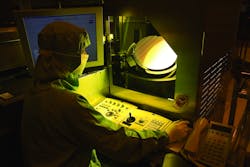Scientists Invent Elusive Gallium Nitride Transistors
For years, engineers have struggled to create GaN transistors with complementary metal-oxide-semiconductor or CMOS technology. But recently, scientists reported a field-effect transistor based on GaN CMOS, paving the way for chips that replace silicon in everything from wireless amplifiers to power converters.
Based out of HRL Laboratories, a research institute funded by General Motors and Boeing, the researchers were able to fabricate a chip with an enhancement-mode n-channel MOSFET and a p-channel MOSFET on the same GaN wafer. The results were published last month in the journal IEEE Electron Device Letters.
Rongming Chu, the project’s lead researcher, said that putting “power switches and their driving circuitry on the same chip is the ultimate approach to minimizing" parasitic inductance, the biggest obstacle to GaN CMOS. Before, engineers intentionally slowed down GaN's switching speed to prevent voltage instabilities that limit performance.
GaN operates at higher temperatures and voltages than gallium-arsenide, which has been used for decades in microwave and radio frequency power amplifiers. GaN transistors are making a splash in cellular stations, antennas, and radar. Lockheed Martin recently used GaN in its latest radar technology.
One of the major benefits of CMOS, the researchers said, is its intrinsically low manufacturing cost. GaN CMOS could be a huge breakthrough for that reason alone: the low cost of silicon chips has slowed down the success of GaN. Until recently, most researchers considered GaN CMOS impossible, Chu said.
The problem had always been how to go about making the GaN p-channel transistors and integrating them with n-channel transistors, which control the flow of electrons through the integrated circuit. But using a process called selective area epitaxy, the HRL researchers squeezed both of these power transistors on the same chip. They used that approach to fabricate an inverter chip in GaN CMOS.
About the Author

James Morra
Senior Editor
James Morra is the senior editor for Electronic Design, covering the semiconductor industry and new technology trends, with a focus on power electronics and power management. He also reports on the business behind electrical engineering, including the electronics supply chain. He joined Electronic Design in 2015 and is based in Chicago, Illinois.
